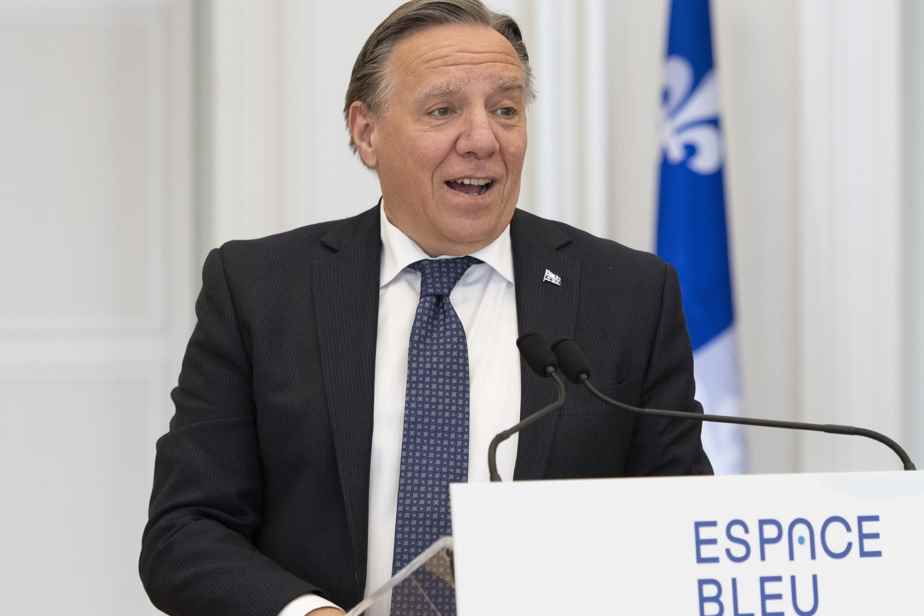(Quebec) The Blue Spaces odyssey has hardly begun when the bill is already skyrocketing, while everything remains to be done.
Posted at 5:16 p.m.
And no one in the government is going to venture to predict how much this megaproject for a network of regional cultural venues will cost, a new kind of initiative dear to Prime Minister François Legault, and whose formula has yet to be defined, a year after its launch.
When the project was announced on June 10, 2021, the network of 18 Blue Spaces across Quebec was to cost $259 million. Today, it is rather estimated at around 300 million at the Ministry of Culture, while the project remains embryonic.
A year later, an artistic vagueness halos this cultural project, with poorly defined contours, of which no one wants to specify the exact nature and especially not the final cost. Blue Spaces seem to have a blank check.
Fixing the amount of the total bill for Blue Spaces would be “pure fiction”, admits the one who oversees the project, the director of the Museum of Civilization, Stéphan La Roche, in a telephone interview recently with The Canadian Press, with a view to making the point one year after the launch of the project. He admits “not being able to answer this question”.
Since the initial announcement, the government has refused to say when visitors will have access to the entire network of these cultural sites dedicated to the history of the regions and the specific identity of each. Today, we risk bringing forward the year 2026, therefore at the end of the next mandate. “That’s our hope and our ambition,” cautiously summarizes Mr. La Roche, who does not, however, make any commitment regarding deadlines.
And what is the progress of the work, one year after the launch of the Blue Spaces project?
None are yet open to the public. Of the total of 18 new cultural sites promised (17 Blue Spaces in the regions, plus the headquarters in Quebec), there are currently only three projects: Quebec, Percé and Amos, which is at the plans and specifications. A fourth should start shortly in Baie-Saint-Paul.
Elsewhere, i.e. in the vast majority of regions of Quebec, everything remains to be done: prospecting and choosing sites, acquiring heritage buildings, renovating in accordance with the rules for this type of building, developing places, etc. The first Espace bleu should open its doors to visitors, in principle, in the summer of 2023, in Percé.
It is still unclear what will be the mode of management and the operating budget of these quasi-museums financed by the State. It is still “too early” to provide a figure, as to the operating budget granted, according to Mr. La Roche. “The management model is currently being defined”, indicates for its part the Ministry of Culture, in response to a request for information on the subject.
One thing is certain, the discovery of the places will not be free. As in museums, visitors will have to buy their entrance ticket. The amount remains to be determined. The Blue Spaces will therefore have to have independent revenue, the importance of which also remains to be clarified.
We say we want these new cultural venues not to compete with existing regional museums, by acting in “complementarity” with the latter, through a different offer. From the outset, the Society of Quebec Museums had expressed fears, claiming that Blue Spaces should not be set up in cities where there was already a regional museum.
In terms of content to offer visitors, the formula is still in the making, the concept remains to be refined. Mr. La Roche ensures that we will favor tailor-made, as opposed to “wall to wall”. Each Blue Space will therefore have its own style, its own personality, consistent with that of its locality. We also want to develop an “immersive, participatory” style, with permanent and temporary exhibitions.
To avoid missteps, we promise to partner with the community, with local authorities, to ensure that the content will faithfully reflect the identity of the region. A scientific committee will help Quebec choose the key events and identify the “builders” of the region whose exploits will be celebrated, business people, artists, sportsmen and others, who will make up the bulk of the content offered to the public.
Mr. La Roche promises that these cultural places will not only serve to whip up regional pride and that dark episodes of local history, like controversial personalities and more difficult subjects, “will not be evacuated”. There is no political interference in the content to be presented, he assures.
“It’s all in the treatment” of the subject, specifies Mr. La Roche, who describes the future network as the “biggest cultural development project of the last 40 years”.
When making the announcement, Premier Legault clearly said that he wanted to make the Espaces bleus network places where we would celebrate “the pride of being a Quebecer”, not places where we remember the darker moments in local history and the less glorious characters who marked their time.
Mr. Legault added that he wanted to make them “popular” places, which were not “boring” or “dusty” and above all not reserved “for a small elite”.
In these new genre museums, there should also be a multifunctional room, an administrative office and a café, where local products will be showcased.
